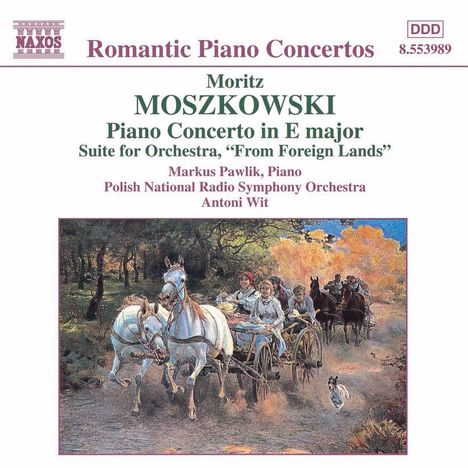Moritz Moszkowski: Klavierkonzert op.59 auf CD
Klavierkonzert op.59
Herkömmliche CD, die mit allen CD-Playern und Computerlaufwerken, aber auch mit den meisten SACD- oder Multiplayern abspielbar ist.
Lassen Sie sich über unseren eCourier benachrichtigen, falls das Produkt bestellt werden kann.
+Orchestersuite op. 23 "Aus aller Herren Länder"
- Künstler:
- Markus Pawlik, Polish Radio Symphony Orchestra, Antoni Wit
- Label:
- Naxos
- Aufnahmejahr ca.:
- 1996
- UPC/EAN:
- 0730099498920
- Erscheinungstermin:
- 8.7.1998
Ähnliche Artikel
Moszkowski vollendete das Konzert 1898 und widmete es "à Monsieur Josef Casimir Hofmann", einem Spieler, der zu einem der größten Klaviervirtuosen aller Zeiten werden sollte. Das Konzert ist für die üblichen Holzbläser, Blechbläser und Streicher notiert, verwendet aber zusätzlich gelegentlich ein Triangel und eine Harfe. Etwas ungewöhnlich für ein Klavierkonzert ist die Tonart E-Dur und die Tatsache, dass es vier statt drei Sätze gibt. Zu Beginn dieses Jahrhunderts war das Moszkowski-Konzert sehr populär, tauchte häufig in den Orchesterprogrammen aller großen Orchester der Welt auf und wurde von den meisten großen Klaviervirtuosen der damaligen Zeit gefeiert.
Die sechs charakteristischen Stücke Aus aller Herren Länder (Opus 23), Opus 23, wurden ursprünglich für Klavierduo komponiert und 1884 veröffentlicht. Im selben Jahr veröffentlichte Moszkowski sie auch in einer Orchesterbearbeitung, und sie wurden zu einem sofortigen Favoriten auf Konzertprogrammen in der ganzen Welt. Bei den sechs Miniaturen handelt es sich um Tanzstücke, die jeweils ein anderes Land repräsentieren und in der ursprünglichen vierhändigen Klavierfassung bestellt sind: Russisch, Deutsch, Spanisch, Polnisch, Italienisch und Ungarisch. Auf dieser Aufnahme ist die Suite wie folgt geordnet: Russisch, Italienisch, Deutsch, Spanisch, Polnisch, Italienisch und Ungarisch. Das Eröffnungsstück ist ein verträumter rosaroter Tanz, der ein wenig an Tschaikowsky und Glazunov erinnert. Als nächstes folgt der italienische Tanz, eine Tarantella. Es folgt der stattliche deutsche Tanz. Als nächstes folgt ein spanischer Fandango, danach hören wir einen schnellen polnischen Tanz. Der abschließende ungarische Tanz ist ein Czardas. Alle sechs Tänze zeigen Moszkowskis Beherrschung des Stils, jeder einzelne eine raffinierte, klare, anmutige, artikulierte Miniatur, voller Charme und rhythmisch beschwingt.
Product Information
Moszkowski completed the concerto in 1898, dedicating it "à Monsieur Josef Casimir Hofmann", a player who was to become one of the greatest piano virtuosi of all time. The concerto is scored for the usual woodwind, brass, and strings, but in addition, it makes occasional use of a triangle and a harp. Somewhat unusual for a piano concerto is the key of E major, and the fact that there are four movements instead of three. At the beginning of this century, the Moszkowski concerto was very popular, appearing frequently in the orchestral programmes of all the major orchestras of the world, and championed by most of the major piano virtuosos of the time.
The six characteristic pieces Aus aller Herren Länder (‘From Foreign Lands’), Opus 23, were originally composed for piano duet and were published in 1884. In the same year, Moszkowski also published them in an orchestral arrangement, and they became an instant favourite on concert programmes all over the world. The six miniatures are dance pieces, each representing a different country, and in the original four-hand piano version are ordered: Russian, German, Spanish, Polish, Italian and Hungarian. On this recording, the suite is organized as follows Russian, Italian, German, Spanish, Polish and Hungarian. The opening piece is a dreamy Rossian dance, somewhat reminiscent of Tchaikovsky and Glazunov. Next is the Italian dance, a tarantella. The stately German dance follows. A Spanish fandango is next, after which we hear a fast Polish dance. The concluding Hungarian dance is a czardas. All six of the dances show Moszkowski's mastery of style, each one a refined, clear, graceful, articulated miniature, full of charm and rhythmically buoyant.
Rezensionen
K. Franke in FonoForum 1/99: "Das Ganze ist pianistisch blendend gefaßt; da funkelt und fliegt es, perlt und charmt es, dass es die Seele freut; und zwischendurch stockt man bei Passagen abgrundtiefer Sentimentalität."Disk 1 von 1 (CD)
-
1 Piano Concerto in E major, Op. 59: I. Moderato
-
2 Piano Concerto in E major, Op. 59: II. Andante
-
3 Piano Concerto In E Major, Op. 59: Iii. Scherzo: Vivace
-
4 Piano Concerto in E major, Op. 59: IV. Allegro deciso
-
5 Aus aller Herren Landern (From Foreign Lands), Op. 23: I. Russian: Allegretto
-
6 Aus aller Herren Landern (From Foreign Lands), Op. 23: II. Italian: Presto
-
7 Aus Aller Herren Landern (From Foreign Lands), Op. 23: Iii. German: Andante
-
8 Aus aller Herren Landern (From Foreign Lands), Op. 23: IV. Spanish: Molto vivace
-
9 Aus aller Herren Landern (From Foreign Lands), Op. 23: V. Polish: Allegro con fuoco
-
10 Aus aller Herren Landern (From Foreign Lands), Op. 23: VI.Hungarian: Molto allegro
Mehr von Moritz Moszkowski
-
Moritz MoszkowskiViolinkonzert op.30CDVorheriger Preis EUR 19,99, reduziert um 0%Aktueller Preis: EUR 9,99
-
Moritz MoszkowskiSuite für 2 Violinen & Klavier g-moll op.71CDAktueller Preis: EUR 19,99
-
Moritz MoszkowskiKlavierkonzert h-moll op.3CDAktueller Preis: EUR 19,99
-
Moritz MoszkowskiKlavierkonzert op.59CDAktueller Preis: EUR 19,99








